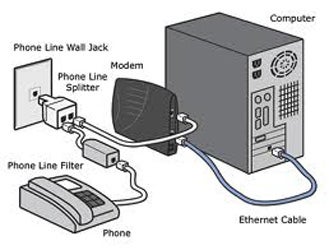Internet Terms and Definition
·
Anti-virus Program
·
Software that Monitors a computer for viruses
and eliminates them before damage occurs.
·
Applet
·
A small program, written in language called “JAVA”
that can be placed in a web page and runs automatically when the page opens on
your computer.
·
Applets are normally used for special effects.
·
Archive
·
A repository for software, data, or other
materials to be saved and preserved. FTP sites are known as archives.
·
ASCII (American Standard Code for
information Interchange)
·
A code used by computers to represent all the
letters, numbers, etc on a computer keyboard.
·
Bandwidth
·
How much stuff you can send through a connection
to the internet.
·
Baud Rate
·
The rate at which a modem (The Piece of
equipment that canconnect your computer to the internet) can send or received
information.
·
BBS (Bulletin Board System)
·
The computerized equivalent of a notice board.
·
Binary
·
A number system based on zeros and ones (0 and
1)
·
Bitmap
·
A graphic which is defined by specifying the
colors of dots or pixels which make up the picture. Common types of bitmap
graphics are GIF, JPEG, Photoshop, PCX, TIFF, BMP, and TGA.
·
Blogs or Blogging
·
A blog is a way for someone to present a running
journal for a wide variety of a readers.
·
Bookmark
·
A way for web browser user to mark a web page
they want to return to later.
·
Bounce
·
The return of an e-mail message because of an
error in its address.
·
Bug
·
A bud is programming error that causes a program
or computer system to perform erratically, produce incorrect results or crash.
·
Byte
·
A measurement of data. Usually there are 8 bits
in a byte- sometimes more, depending on how the measurement is being made.
·
CGI
·
A small program that takes information entered
on a web page and does something with it, like turning a web form into an
e-mail message. Examples of CGI programs are web site guestbooks or online
shopping facilities.
·
Chain Letter
·
A form of SPAM which ask you to distribute the
letter to many people.
·
Chat
·
A Form of real time electronics communication
where participants type want to say, and it is repeated on the screens of all
other participants in the same chat.
·
Chat Room
·
A place on the internet where people go to “CHAT”
with other people.
·
Client
·
In Internet Terms, it’s an application that
performs a specific functions, such as telnet or FTP.
·
Counter
·
A number seen on some web pages which indicates
the number of visits the page has had
·
Cyber Space
·
A word used to describe the internet. The term was
coined by science-fiction novelist William Gibson in 1984 in neuromancer.
·
Database
·
A collection of data records. On web databases,
records may consist of web pages, or graohics or audio files, or newspaper
files, or books, or movies, or press releases or almost anything from very
general to very specific areas of interest.
·
Dedicated Line
·
This is a communication line that is used solely
for computer connections
·
Dial-up
·
This is widely used method of accessing the
internet.
·
Domain Name
·
The unique name that identifies an internet
site.
·
Download
·
The transfer of information from a computer on
the internet onto your computer.
·
Electronics Mail
·
Messages sent from one person to another via
computer.
·
Ethernet
·
A very common method of linking computers
together.
·
FAQ(Frequently Asked Questions)
·
Documents that list and answer the most common questions
on a particular subject.
·
Firewall
·
Firewalls are special computers or computer
Programs that are set up on a network.
·
FTP(File Transfer Protocol)
·
Generally, any text that contains links to other
documents.
·
A very common method of moving files between two
computers.
·
GIF(Graphic Intechange Format)
·
A type of image file commonly found on
the world wide web.
·
Giga Byte
·
A measure of stored information on a computer.
·
Hacker
·
Perform other destructive or illegal acts with
computers and networks.
·
Header
·
Headers are not normally visible when reading
emails or newsgroup.
·
Hits
·
The number of pieces of information downloaded
from a web site.
·
Homepage
·
The main, or front, web page for a business,
organization, person.
·
Host
·
May be the computer on which a web site is
physically located.
·
HTML (Hypertext Markup Language)
·
The script Language used to create web pages.
·
HTTP (Hypertext Transport Protocol)
·
The Language used by computers on the world wide
web to communicate one another.
·
Hyperlink
·
Hyperlinks are words, phrases, or graphic images
that have URL’s hidden in them.
·
Hypertext
·
Generally, any text that contains links to other
documents.




